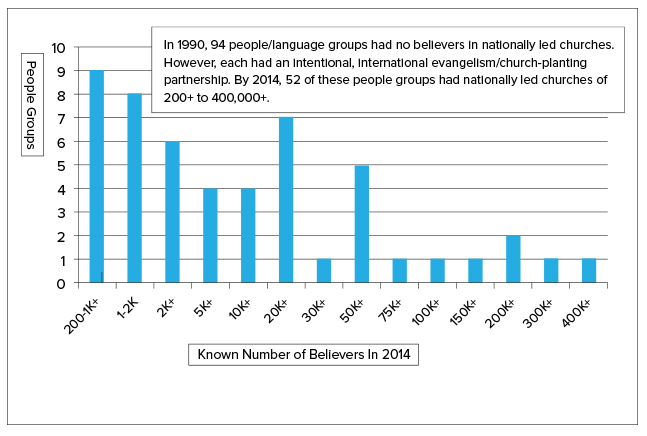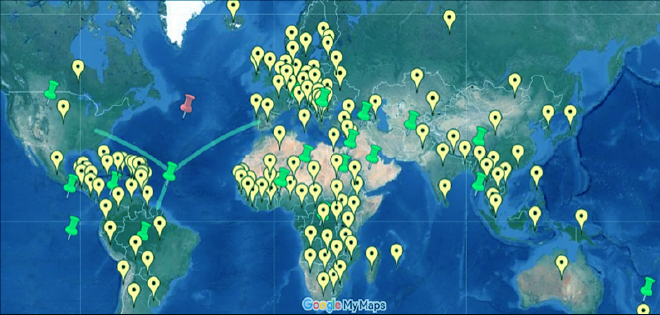‘There is no other way society will achieve large-scale progress against urgent and complex problems, unless a collective approach becomes the accepted way of doing business.’ Stanford Institute of Social Innovation Journal, Spring 2012.
Manuel Castells, the most frequently cited sociologist of our day, states in the preface to his landmark book, The Rise Of The Network Society: ‘Because networks do not stop at the borders of the nation-state, the network society constituted itself as a global system, ushering in the new form of globalization characteristic of our time.’
Evaluation of effectiveness is essential to stewardship and is part of the nature of God: planning, executing, and then evaluating.[1]
The scale of the network/partnership challenge
It is in hundreds of kingdom-focused networks that the global church is now meeting virtually and in the field: organizing themselves collaboratively with a geographic or issue-specific focus and in many cases integrating both perspectives.[2]
With 500+ entries and constantly expanding, the explosive growth of the movement is compiled and managed by Eldon Porter, Global Engagement Consultant. Map courtesy of www.linkingglobalvoices.com. Visit the website for a wealth of current network information.
Proliferation of types of ministry, radical socio-political and communication change, multiplication of ministry ‘adhocracies’, and the shift of the global church’s center of gravity to the east and south, make evaluation more urgent than ever. Lacking collective action on the topic of network evaluation, the wider ministry community and those who support these efforts are destined for continued confusion about essentials and our ability to evaluate them. The urgency of the need is evident.
This article highlights the challenges, progress, and options that now exist for evaluating these radically new structures shaping the future of ministry globally.
Network and partnership[3] evaluation—for whom and why?
Who?
A variety of stakeholders have or should have an interest in the effectiveness of their collaborative ministry efforts. Among them are:
- the leaders or facilitators of collaborative efforts;
- the participants in the network or partnership;
- the leaders who approve investment of people, time, money, etc, in the collaborative effort; and
- the direct financial investors in collaborative efforts.
Why?
- Obviously a kingdom sense of stewardship should be a primary motivation.
- Beyond that, particularly as increasingly standard terms and categories are used, evaluation can power a growing international learning community.
- There is increasing demand for effective external reporting: accountability to parent ministries, prayer, and financial partners.
However, high motivation should never be assumed, as recently observed by Steve Moore of Next Leader: ‘The danger isn’t just that some leaders don’t know what they don’t know. It is they don’t want to know what they don’t know, at least not badly enough to create effective feedback loops.’[4]
Evaluation baselines and invested players
Expectations regarding evaluation by ministry networks are heavily colored by assessment practices established outside traditional ministry sectors, such as the worlds of business or social and physical sciences. To place ministry partnership evaluation in perspective, an understanding of the contrast between ‘secular’ and ‘ministry’ evaluation is essential.
In the physical and social sciences, there is a rich history of documentation, metrics, and evaluation. Legislation, budgets, career aspirations, industry standards, professional commitment to excellence, and other factors all play a part at different times in motivating evaluation. In sectors such as education, crime, public health, and dozens of other fields, there is a long history of documentation that yields a wide-ranging base of largely agreed metrics.
The emergence of intentional multi-agency, multi-stakeholder partnerships in these traditional ‘secular’ sectors is a fairly recent phenomenon. However, the impact of these initiatives and curiosity regarding their effectiveness have gained considerable attention over the last five years. Administrators, operations personnel, and policy makers are all engaged in the discussion.
Beyond that, financial stakeholders are forming their own learning communities to understand what makes for good investment in collaborative efforts; how networks call for different thinking from investments in single organizations; and what is involved in evaluating such collaborative efforts.[5]
Challenges among Christian ministries
Among Christian ministries, the story is quite different. There is little or no agreement on what numbers are truly significant regarding short or longer-term spiritual outcomes or impact of the gospel. Historically the ministry world has used largely generic numbers: number of people in a gospel meeting or that ‘go forward’ in response to an evangelistic message; size of church membership or numbers who actually attend; size of Christian magazine circulation; number of people who ‘respond’ to a radio or TV program; or number of missionaries supported or ‘on the field’. Efforts to assign meaning to the numbers—much less, longitudinal studies to examine trends or implications—have been rare.
Recently with the advent of social media, Christian communications ministries suddenly seemed to have an arsenal of new data. Google Analytics (and other similar tools) provide a torrent of information. There was hope. Initially among both ministry leaders and their financial supporters, there was a bubble of euphoria: ‘At last we have some specific numbers from a third party’. However, the lack of agreement on the categories of response (indicators) to be analyzed—much less, their meaning regarding lasting spiritual impact—has created new confusion and frustration.
The world of Christian foundations, where professional staff members are charged with examining effectiveness, has seen an increasing focus on evaluation. The effort to separate ‘activities’ and ‘outcomes’ has been widespread and is commendable. Despite this healthy push for more objective assessment, there has been a continuing lack of common vocabulary and commonly agreed categories for evaluation. Even more challenging is the lack of agreement on the significance of such ministry ‘outcomes’, their causes, or their correlation with long-term outcomes such as the number of mature believers and the health of grassroots fellowships. Even the meaning of such terms has largely gone unexamined.
What is there to measure in partnerships and networks?
Shortly after what many call the birth of the modern ministry partnership movement in 1986,[6] there was an evident need for evaluation.
Since then, experience of the last 30 years has identified three broad categories that can and should be evaluated:
- The scale of the challenge
- The nature of the network: its development and the effectiveness of its organization and operation
- The nature of the network’s outcomes: specificity and realization of stated objectives
By 1990, the emerging partnership movement was evaluating each of these three sectors of information at varying levels of depth and consistency.
1. The challenge: both scale (numbers) and where and who?
The majority of international ministry partnerships over the last 30 years has been focused on some aspect of frontier evangelism.[7] Providing a framework for strategic evaluation was the focus of the early effort of groups such as the Joshua Project, the US Center for World Evangelization (now Frontier Ventures), Operation World, and the research arm of the Southern Baptist International Mission Board. There exists an increasingly definitive database of the ‘unfinished’ challenge as these groups share information and continue to refine methodology. Currently a global network of researchers regularly track progress and share information to update the databases.
2. The nature of the network
Here, two issues emerged:
A. Key elements of effective partnership development could be defined and documented. In other words, progress toward a potentially effective collaboration could be evaluated. These elements are broadly grouped into assessment of three ‘stages’ of development:
- Exploration (research and due diligence)
- Formation (the critical go/no-go stage based on consensus)
- Operation (clear vision, achievable objectives, and full partner engagement)
B. Key indicators of partnership operational effectiveness were defined. These shape the likelihood of the partnership realizing its primary or other specific, related objectives. Among those agreed key indicators are:
- Levels of prayer support
- Clarity and specificity of objectives
- Strength and continuity of leadership/facilitation
- Limited achievable, measureable near-term objectives
- Clear definition of timelines and responsibility
- Effectiveness of internal communications
- Levels of partner engagement
- Commitment to regular network evaluation
Examples of both evaluation tools and of objectives set and realized in the two broad categories above can be found at http://bit.do/NetworkEvalExamples.
3. The nature of the network’s outcomes: realization of stated objectives
As the partnership/collaboration movement matured, of particular significance was the realization that time and ability to achieve certain objectives was a critical consideration. Collaboration objectives and the potential for their evaluation fell into a range of short to medium-term objectives as well as longer-term ones. Naturally, the formation and effective operation of partnerships fell more within the influence of those working to launch and sustain these partnerships. The ‘big picture’ outcomes often related to enormously challenging Great Commission issues. Typically these outcomes called for change of centuries-old patterns and complex variables that were not directly influenced, much less controlled, by the partnerships.[8]
In one effort to examine the long-term impact of the partnership movement, a 2014 study looked at 94 operating strategic evangelism partnerships[9] and their longer-term outcomes. This chart summarizes that research as of 2014.

When the partnerships were launched, each of these groups had been in spiritual darkness for hundreds of years. The fact that these outcomes occurred within roughly one generation suggests a quite compelling case for kingdom collaboration. This is particularly so, as during the same period, no known large-scale number of new believers and establishment of local fellowships has been documented among any completely ‘unreached’ people group where there has been no collaborative approach.
Recommendations on ways forward
Without financial accountability, such as that provided by ECFA in North America, the evangelical community has no counterparts to the motivation and demand for ‘industry standards’ that exist in the physical and social sciences or business worlds.
Motivated primarily by the desire for the highest expression of stewardship, the evangelical community is faced with urgent challenges and unprecedented opportunity.
Here are five suggestions for action that could yield significant progress:
- There needs to be a radical and broad new level of commitment to common working, acknowledging that effectively addressing challenges such as the fulfillment of the Great Commission can only be done collaboratively. In response, ministry leadership, field personnel, Boards of Trustees, and kingdom investors need strongly to affirm, support, and engage in practical collective action.
- Based on widely acknowledged secular research, funders need to take a serious look at their investments in single ministry, single strategy approaches, as opposed to collective approaches such as effectively operated ministry networks and partnerships.
- Kingdom investors must get behind specific initiatives to develop common language, categories for evaluation, and standards of documentation and reporting. Their efforts will have a disproportionate impact, certainly ‘getting the attention’ of field ministry leadership.
- A global, coordinated documentation of developing and operating partnerships similar to the documentation done from 1990–2000 would provide extraordinary dividends for both operations personnel and kingdom investors alike. This is an ideal opportunity for real collaboration.
- Working discussions should be launched between funders, ministry leadership, and seasoned partnership practitioners to explore practical action on common vocabulary in defining the nature and specific elements of critical sectors of ministry operations and collective efforts[10] and common standards for evaluation of kingdom-focused collaborative initiatives.
Endnotes
- I have written substantially on God as a planner and the associated evaluation called for. Sufficient to say here that passages such as, ‘And God saw everything that he had made, and it was very good’ (Gen 1:31a); ‘I have brought you glory on earth by finishing the work you gave me to do’ (John 17:4); ‘Suppose one of you wants to build a tower. Won’t you first sit down and estimate the cost to see if you have enough money to complete it?’ (Luke 14:28, see Luke 14:28-32); the seminal passage on stewardship, evaluation, and responsibility, the parable of the stewards (Matt 25:14-30) make what seems to be a compelling biblical case for the responsibility of ministry leaders to establish clear, measurable objectives and do the associated evaluation. And, of course, Jesus’ telling words, ‘I have finished the work you sent me to do’ in John 17:4 clearly reflect an explicit goal and assessment that it had been achieved.
- Editor’s Note: See article entitled ‘Engaging an Emerging Generation of Global Mission Leaders’ by Nana Yaw Offei Awuku in the November 2016 issue of Lausanne Global Analysis. ↑
- While, technically, there are distinctions, I have used the words ‘partnership’ and ‘network’ interchangeably throughout to represent the range of coalitions that engage multiple agencies/stakeholders in a common vision for change.
- Steve Moore/ABHE, ‘Closing the Feedback Loop: Why What You Don’t Know Will Hurt You and How to Find Out’ vlog, Nexleader Ideaportal, 18 February 2016. http://ideas.nexleader.com/?p=447.
- Over the last four years, the Stanford Social Innovation Review (SSIR) has initiated and published a series of probably the most wide-ranging, lucid, and helpful articles on the rise of these collaborative initiatives: efforts to understand them, essentials for their success, and means for evaluating them. SSIR has conveniently clustered these articles at one web address: http://ssir.org/articles/entry/collective_impact. The SSIR has also covered the increasing engagement of funders in collaborative initiatives and the unique challenges they bring. Here are three representative articles: http://ssir.org/articles/entry/high_stakes_donor_collaborations, http://ssir.org/articles/entry/making_nonprofit_collaboration_a_foundation_strategy_the_lodstar_foundation, and http://ssir.org/articles/entry/accepting_the_challenges_of_partnership.
- There have been some notable exceptions. In Western urban ministry settings, Christian partnerships have worked alongside, or in some cases, actually led other ‘secular’ urban agencies in addressing one or more of the well-documented social issues. A range of key leaders and associated groups has sought to foster effective urban ministry partnerships. Among those active are www.goodcities.net, Communities Inc at www.communitiesinc.org, Mission America’s city initiatives at http://www.missionamerica.org/Brix?pageID=13209, and Frontline Ministries at http://flministries.org/about/.
- In June 1986, 15 evangelical mission leaders from 12 or more mission agencies met in Malaga, Spain, representing a wide range of different theological, traditional, and ministry types. Their common commitment was to see spiritual breakthroughs in Tunisia, Algeria, and Morocco. Following three days of intensive prayer and hard work, they achieved consensus on specific action objectives. That initiative just celebrated its 30th anniversary at the January 2016 conference, where 500 or more participants reflected dozens of partnership initiatives in the region. By the early 2000s, the Malaga-rooted movement had seen strategic evangelism partnerships launched in 94 ‘unreached’ people groups.
- Goals of getting a new collaborative radio program on the air, a new evangelistic website operational, translating the New Testament (even aided by machine translation), or seeing an emerging local, healthy church after 1,900 years of darkness are very different in their complexity and the time required. They present unique challenges for the nature of collaboration, realistic timelines/expectations, and therefore, basis for evaluation.
- The pioneering partnership development agency Interdev focused on an objective of helping the global church launch sustainable international collaborative evangelism and church planting in a select, priority list of 130 ‘gateway’ languages. (The objective was developed following substantial discussion with an advisory group of evangelical missiologists, linguists, and anthropologists.) In the early 1990s, a straightforward Excel database was established and updated monthly, monitoring several key indicators regarding partnership development progress or lack of it. This database was consistently updated monthly through to mid-2002, by which time 94 of the target 130 languages had operating strategic evangelism partnerships. More than 20 other language groups at the time were documented as having partnerships in various stages of development.
- For a detailed examination of the potential value of common vocabulary with particular reference to Christian media and its role in evangelism and strengthening the church, see the paper ‘The Need For Common Vocabulary To Strengthen Media Follow-Up Efforts’ at http://bit.do/MediaCommonVocab. The principles outlined in this paper are widely applicable to an evangelism/church-planting partnership’s longer-term strategy.


